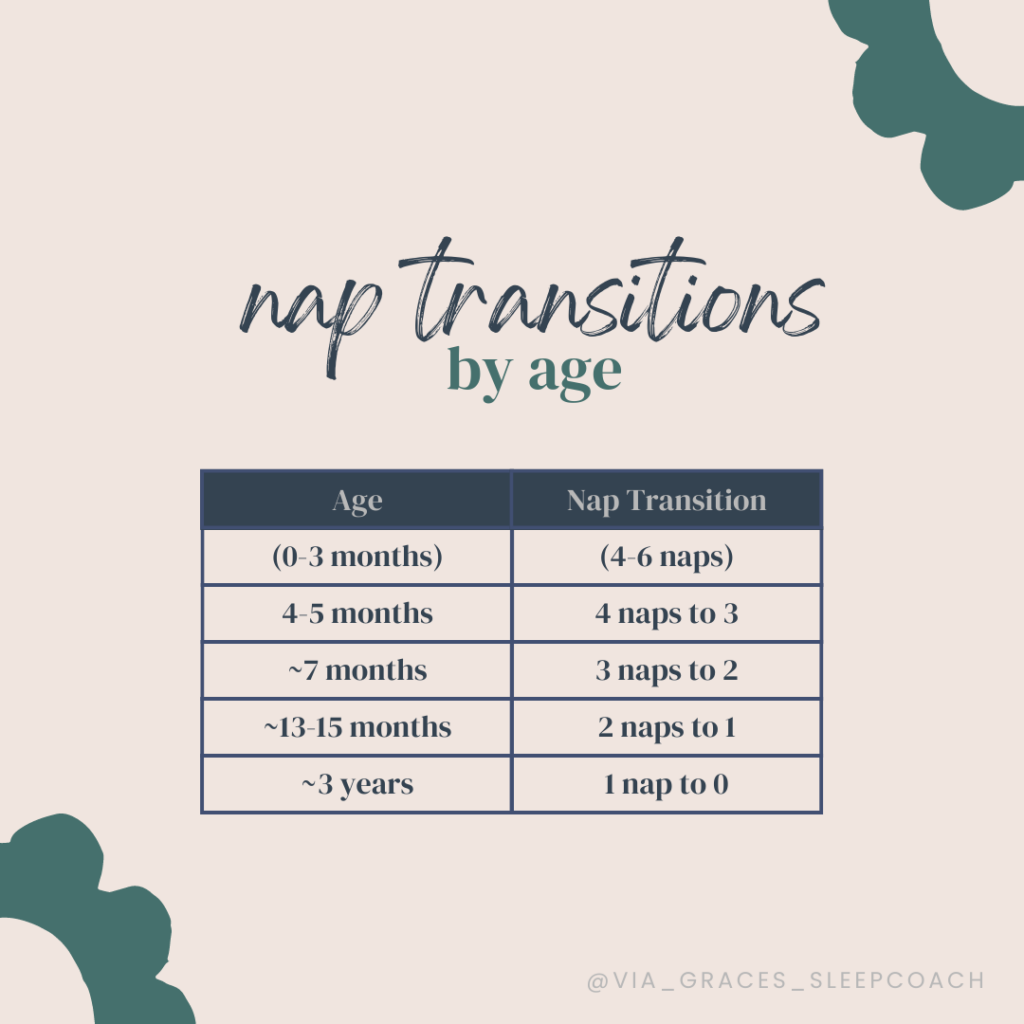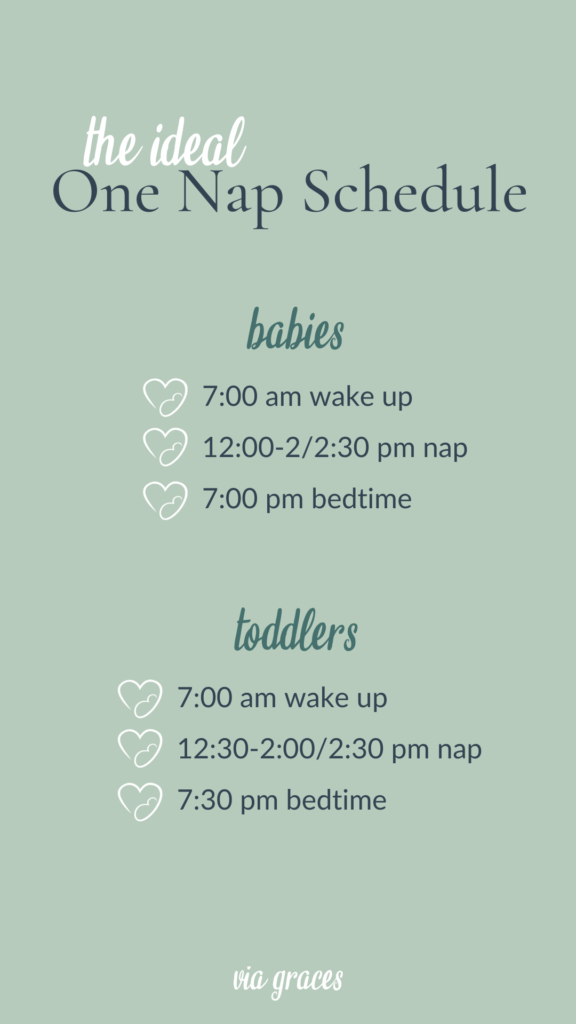When I work with families one-on-one, I often say that naps tend to be the hardest part of the sleep puzzle. That’s because daytime sleep is just plain different than nighttime sleep, and if sleep is going to get thrown off by a change, it’s likely the naps that will take the first or hardest hit.
And transitioning from two naps to one nap is definitely a tough transition – in my opinion, it’s the hardest (though it probably rivals dropping the nap altogether)! But it might also be the most exciting, as you now have most of the morning and much of the afternoon to get out of the house and not race back for a mid-morning and mid-afternoon nap!
So let me help you…
In this blog post, I will explain the following:
- What age babies/toddlers are usually ready to transition to taking one nap
- The best one-nap schedule for babies and toddlers
- How to go about transitioning from two naps to one
- The ideal nap length on a one-nap schedule
- What to expect with the two-to-one nap transition
- How long nap transitions usually take
What age are babies/toddlers usually ready to transition to one nap?
Most babies are ready to make this transition between 13-15 months, although I’ve seen some babies transition as early as 12 months old, and I’ve seen others hang on until 18 months!
One reason this transition is so hard is simply determining when to make it. There are so many developmental milestones happening around the same time (namely walking and talking) that can make it tough to determine if it’s a sleep regression we simply need to wait out or if a schedule change is appropriate.
My general rule of thumb is when your baby or toddler’s sleep seems off and you’re questioning a schedule change (such as the two-to-one nap transition!), first WAIT about two weeks before making a big sleep change to rule out a regression due to a milestone. This will prevent you from making a transition too soon, which could then result in further sleep challenges.

If your baby is in daycare, they will likely transition to one nap at 12 months old…
If your baby is in daycare, there is a very good chance they will be moved to a new room around 12 months old and will be put onto a one-nap schedule. This can be frustrating to some families, as your baby might not actually be ready for this transition, but it’s happening.
First, I want to say, you are not alone. Pretty much every daycare family I know and have worked with has gone through this! It will be okay.
If this is you, know that your little one is very likely going to need an early bedtime of 6 or 6:30 pm for a few weeks as they adjust to this new schedule. Even if they start taking a longer afternoon nap pretty quickly, they’ll probably still need an earlier bedtime.
Or if they are struggling and taking a super short afternoon nap, they may benefit from a few extra minutes in the car on the way home to catch a little snooze.
You can certainly switch to one nap at home when your baby switches to one nap at daycare, but if it seems that your baby really still needs two naps, I recommend trying to stick with two naps on the weekend. As long as they’re still sleeping well for those two naps and overnight, stick with it!
And if you get to a space where overnights are starting to get off or naps just aren’t working, their body clock could just be getting too confused by such different schedules during the week and weekend. So if that’s the case, I would recommend transitioning to just one nap.
This is what we did with our oldest! She was at a preschool that went until 1 pm and they didn’t offer a morning nap. So she’d fall asleep on the car ride home, our sitter would transfer her to her bed, and she’d thankfully keep sleeping and take a great nap. I don’t remember for how long, but she still took two naps on the weekends for quite some time before officially going to one nap across the board.
Signs babies are ready to transition to one nap
The most common sign it’s time to transition to just one nap is that your little one’s afternoon nap is becoming a struggle. They likely still take a great morning nap but either refuse the afternoon nap altogether (by protesting or just happily not sleeping), it takes longer than 20 minutes to fall asleep, or they’ll only nap for about 30 minutes.
Your child may also take a short morning nap and a short afternoon nap.
Another sign your baby is ready to transition to one nap is they are struggling with early morning wakings, or even prolonged wakings in the night, and that’s all due to a lack of sleep pressure.
[Sleep pressure is what our kids build up during the day, both between naps in order to fall asleep well and have a nice and long nap, AND to sleep well through the night! If our kids don’t have enough sleep pressure built up from the day, they may struggle with night wakings and/or starting the day super early, so that’s another sign it’s time to transition to one nap.]
Finally, it’s time to transition to one nap if your baby’s bedtime continues to get pushed back later and later. Ideally, your baby’s bedtime would not be later than 8 pm, because we want them to have time to get 11-12 hours of nighttime sleep. And if bedtime has to get pushed much later in order to squeeze in both naps and be tired enough at bedtime, it’s time to make the transition.
But remember, just because you have one or two off days does not mean it’s time to transition naps! Naps may not be a challenge every day, but if they are a struggle for the majority of the time over two weeks and you’re still not seeing an improvement, it’s time to transition to one nap.
The Best One Nap Schedule for Babies and Toddlers
The end goal is a schedule that looks something like this:
- 7:00 am wake up
- 12:00-2:00/2:30 nap
- 7:00 pm bedtime
As your toddler gets older, that may shift to something more like this:
- 7:00 am wake up
- 12:30*-2:00/2:30 nap
- 7:30 pm bedtime
*You may have to continue pushing your toddler’s nap time later and later, however I do not suggest pushing it any later than 1:00 pm.

How long your baby/toddler’s nap should be on a one-nap schedule
Your little one will ideally slip into a regular schedule of taking a 2-2.5 hour nap every afternoon.
1.5 hours is the minimum nap length we like to see when on a one-nap schedule, and we’ve occasionally seen babies/toddlers who take three-hour afternoon naps and still get 11-12 hours at night. If that’s the case, great! But more often than not, 2-2.5 hours seems to be just right for one nap days.
How to make the switch from two naps to one nap
To help your little one adjust to a one-nap schedule, I do NOT suggest going cold turkey and jumping right into the new schedule. This is a big change and we need to help them get there!
So we’re essentially going to be taking their morning nap and slowly moving it later and later so it eventually becomes the one and only afternoon nap. We’ll do this by delaying their current morning nap by 30 minutes every three days until that nap time reaches your desired time (I suggest families start with a noon nap!).
For example, if your child typically takes a nap at 10:00 am but it’s time to transition to one nap, this morning nap adjustment will look like:
Days 1-3: Nap at 10:30
Days 4-6: Nap at 11:00
Days 5-7: Nap at 11:30
Days 8-10: Nap at 12:00
If your child wakes up before noon while slowly delaying that morning nap, try to put them down for an afternoon nap. They may not actually sleep, but give them some time to try to sleep/at least rest in their crib for about 30 minutes. You can also plan to be on a walk with the stroller or carrier, or driving in the car at this time to squeeze in a little nap.
As you continue bumping that morning nap back later and later and they sleep past noon, do not offer an afternoon nap that day. It will likely be a stretch, but go ahead and do an early bedtime that night (around 6/6:15 pm!). This will help make up for the afternoon sleep they’re used to getting, and it will also help avoid any extra overtiredness.
During the first week of this transition, your little one may have a two-nap day, then a one-nap day, then two naps, etc., but soon you’ll come to a place of consistency where every day is a one-nap day. However you will likely still need a 6/6:30 bedtime for a bit!
Do NOT do this when transitioning to one nap…
A temptation I have found families fall into is they start pushing the morning nap later and find a sweet spot around 11 or 11:30 am, so they pause there. KEEP GOING!! If the goal is to get your child’s nap to noon, keep pushing to noon – even if that means their nap gets shorter for a bit before it gets long again.
If you pause the nap transition early and sit at 11/11:30 am, for example, it may work for a short time, but then your little one will likely start struggling. They may have a tough time lengthening their nap to the full two hours, or they might get stuck at a 6:30 pm bedtime because their whole schedule is pulled forward, or they may start waking in the night or early in the morning due to overtiredness or even just an off schedule!
So keep going until your little one’s nap reaches noon.
DO THIS once on a one-nap schedule…
Once your baby/toddler has fully adjusted to their new one-nap schedule, stick to that schedule as closely as possible, just like you did when they were on a two-nap schedule!
If your little one usually wakes up around 7 am and naps at noon, yet randomly wakes at 6:30 am one morning…keep their nap at noon! Similarly, if they usually nap until 2 pm and for some reason wake up at 1:30 one day, stick with the 7 pm bedtime!
Yes, if they wake up at 5 am, they’ll likely need a bit of an earlier nap, but try not to go much more than 15 minutes earlier (30 minutes maximum). Or if they only nap for 30 minutes, or don’t nap at all, they’ll need an earlier bedtime. But in general, try to stick with this schedule as closely as possible, as this is best for your child’s little body clock!
For more real-life examples of what “off days” might look like and how to adjust schedules accordingly, check out Big Kid Sleep from A to Z! There is a whole section on schedules and how to adjust them.
Final tips for the transition to one nap
- Your little one will likely seem to “hit a wall” at their old morning nap time (around 10 am), so try to get outside and/or offer a snack with some natural sugars in it (i.e. fresh fruit!) to push through. They will get a second wind!
- While the transition to one nap is still new, try to avoid stroller rides, car rides, and anything else that generally puts your child to sleep around 10/11 am (their old morning nap time!)
- Aim to have lunch right before nap time, as if lunch is part of your little one’s nap routine. This will help them transition more smoothly to nap time rather than get distracted with play and have to transition again a few minutes later!
- The one-nap transition will impact your little one’s entire body clock. You may find that your baby’s appetite is different; they may seem hungrier than usual, especially between their nap and dinner time, and that’s normal! You may also find that their pooping schedule changes. Their whole body is going through an adjustment, so it makes sense that their appetite and digestion are, too.

How Long Do Nap Transitions Take?
It generally takes 4-6 weeks for babies and toddlers to fully adjust to any sort of nap transition, and that is certainly true of the two-to-one nap transition.
The actual nap transition itself doesn’t generally take very long – they’ll be taking just one nap a day within a week or two of the transition. That doesn’t, however, mean their body will be fully adjusted!
It may take time for your baby’s nap to fully lengthen, and/or they may still need an early bedtime for a while as they adjust to just one nap. Their meal and snack times will also be adjusting…this is a big transition!
So give it time and give them grace.
Conclusion
Nap transitions can be tough, both on the parents and our babies and toddlers, because it tends to throw any predictability that may have been there out the window. And I get it!
But remember that these transitions are short-lived and are good for you and your little one! And you’ll be back on track before you know it.
If you’d like help walking through this nap transition, or you’ve made it through but something just isn’t working, check out our one-on-one services to see how we can support you!
With Grace,
Lauren